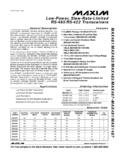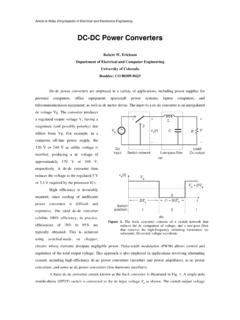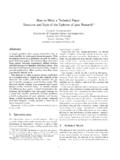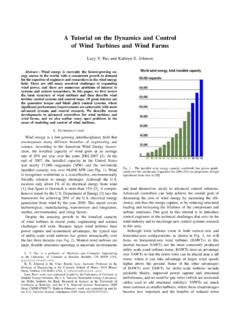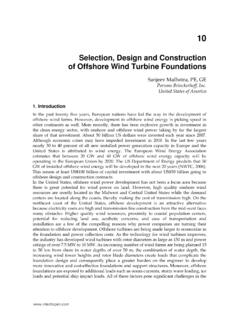Transcription of A Tutorial on the Dynamics and Control of Wind Turbines ...
1 A TutorialontheDynamicsandControlofWindTur binesandWindFarmsLucy Y. Pao and KathrynE. JohnsonAbstract Windenergyis currentlythefastest-growingen-ergysource intheworld,witha concurrentgrowthindemandfortheexpertiseo f engineersandresearchersin are stillmanyunsolvedchallengesinexpandingwi nd power, andthere are , wefirstre viewthebasicstructure ofwindturbinesandthendescribewindturbine Control systemsandcontrol ,wheresignificantperformanceimprov ementsare describerecentdevelopmentsinadvancedcont rollersforwindturbinesandwindfarms,andwe alsooutlinemanyopenproblemsintheareasofm odelingandcontrolofwind INTRODUCTIONWind energy is a fast-growinginterdisciplinaryfieldthaten compassesmany differentbranchesof the AmericanWind Energy Associ-ation,the installedcapacityof windgrew at an averagerate of 29%per yearov er the years2002-2007[1]. At theend of 2007,the installedcapacityin the UnitedStateswas nearly17,000megawatts (MW)andthe worldwideinstalledcapacity was ov er 94,000MW(seeFig.)
2 1). Windis recognizedworldwideas a cost-effective, environmentallyfriendlysolutionto energy onlyabout1% of its electricalenergy fromwind[1], that figurein Denmark is morethan 15%[2]. A compre-hensive reportby the Energy [3] lays theframework for achieving20%of the energygenerationfromwind bythe ,manufacturing,transmissionand integration,market, environmental,and siting amazing growthin the installedcapacityof windturbinesin recentyears,engineeringand windturbineshavepower captureand economicaladvantages,the typicalsizeof utility-scalewindturbineshas grown dramaticallyov erthe last threedecades(see Fig. 2). Modernwindturbinesarelarge, flexiblestructuresoperating inuncertainenvironmentsL. Y. Pao is a professorof ElectricalandComputerEngineeringat the Universityof Coloradoat Boulder, Boulder, E. Johnsonis the ClareBootheLuceAssistantProfessorin theDivisionof Engineeringat the ColoradoSchoolof Mines,1610 IllinoisStreet,Golden,CO Pao s work was supportedin part by the University of ColoradoatBoulderEnergy Initiative, the Energy Laboratory,the MillerInstitutefor BasicResearchin Scienceat the University ofCaliforniaat Berkeley, and the (NSFG rantCMMI-0700877).
3 KathrynJohnson s work was supportedin part bythe (NSFG rantECCS-0725752).Fig. 1. The installedwindenergy capacityworldwidehas grown signifi-cantlyov er the last 2008-2010are projections.[Graphreproducedfromdatain [4]]and lendthemselves nicelyto advancedcontrol helpachieve the ov erallgoalofdecreasingthe costof windenergy byincreasing the effi-ciency, and thus the energy capture,or by reducingstructuralloadingand increasingthe lifetimesof the goalin this tutorialis to introducecontrolengineersto the technicalchallengesthat exist in thewindindustryand to encouragenew controlsystemsresearchin this bothvertical-axisandhorizontal-axisconfi gurations,as shown in , we willfocuson horizontal-axiswindturbines(HAWTs)in thistutorialbecauseHAWT sare the mostcommonlyproducedutility-scalewindtur binestoday. HAWT shave an advantageov er VA WTsin that theentirerotorcan be placedatopa talltower, whereit can take advantageof larger windspeedshigherabove the of the otheradvantagesof HAWTsov er VA WTsfor utility-scaleturbinesincludepitchablebla des,improved po wercaptureandstructuralperformance,and no needfor guy wires(whichare tensionedcablesusedto add structuralstability).
4 VA WTsare muchmorecommon as smallerturbines,wherethesedisadvantagesb ecomelessimportantand the benefitsof reducednoise2009 American Control ConferenceHyatt Regency Riverfront, St. Louis, MO, USAJune 10-12, $ 2009 AACC2076 Fig. 2. Modernutility-scalewindturbinesare very large a Boeing747 and an Americanfootballfieldare includedonthe samescalefor be usedtoimprove power capture and power qualitywhilereducingstructuralloading(an dhencedecreasingmaintenancerequirementsa nd/orextendinglifetime)on the progressionof ever larger turbinesbeingintroducedcommerciallyov er the last threedecades.[Diagramandschematicsfrom[5 ], [6],[7]]and gen-eratingcapacityof moderncommercially-availableturbinesrang esfromlessthan1 kilowatt (kW) to controlis mostcost-effective on larger windturbines,and thereforethis tutorialwill focuson windturbineswithcapacitiesof 600 kW or rest of this paperis organizedas follows. SectionIIdescribesthe configurationsand basicoperationof explainsthe layoutof a windturbinecontrolsystemby takingthe readerson a walk aroundthe windturbine controlloop,includingwindinflow char-acteristicsand availablesensorsand actuatorsfor use describesthe currentstateof windturbinecontrol,whichis thenfollowed by a discussionof the issuesand opportunitiesin windturbineand windfarm controlinSectionsV, VI, VII, and givenin.
5 WINDTURB INEBASICSThe maincomponentsof a horizontal-axiswindturbinethat are visiblefromthe groundare its tower, nacelle,androtor, as can be seen in Thenacellehousesthegenerator, whichis driven by the high-speedshaftis in turnusually driven by a gearbox,whichstepsup the rotationalspeedfromthe connectedto the rotor, kineticenergyin the wind and transformit into the rotationalkineticenergyof the windturbine.(a)(b) horizontal-axiswindturbines.(a) vertical-axisturbinesspin like tops and are advantageousbecausethey don t needto turninto the windand theirheavy components,like generators,can be locatedonthe ground.[Figurefrom[8]] (b) horizontal-axisturbinesare usuallyplacedon tall towersto catchmoreof the windat higherlevels above the ground.[Figurecourtesyof Lee Jay Fingershof the EnergyLaboratory] rotoronthis upwindhorizontal-axisturbine,causingit to low-speedshafttransfersenergy to the gearbox,whichstepsup in speedand spinsthe highspeedshaftcausesthe generatorto spin,producingelectricity.
6 Alsoshown is the yaw system,usedto turn the nacelleso thatthe rotorfacesinto the wind .(Figurecourtesyof the [9].) wind turbine controlgoalsand strategies are upwind, withtherotoron the upwindside of the tower, or downwind. Thechoiceof upwind versusdownwindconfiguration affectsthechoiceof yaw controllerand the turbinedynamics,and thusthe turbinesmayalso be variablepitchor fixed pitch, meaningthat the bladesmayor maynot be able to rotatealong theirlongitudinalaxes. Althoughfixed-pitchmachinesare less expensive initially, the reducedabilityto controlloadsand changethe aerodynamictorquemeansthat they are becomingless commonwithinthe realmof large allor part of theirbladesto rotate alongthe 5. Examplepower curves. The wind Power curve shows the poweravailablein the windfor a turbineof the samesize as the two the exampleturbinesproduceno power in lo w windsbecausethey are not turnedon untilthe windspeedreachesa , power is limitedto protectthe electricaland mechanicalcomponentsof bothturbinesin samepowerat the designpointfor the fixed speedturbine,but the variablespeedturbineproducesmorepower ov er the rest of , windturbinescan be variablespeedor operatecloserto theirmaximumaerodynamicefficiency for a higherpercentageofthe time,but requireelectricalpower processingso that thegeneratedelectricitycan be fed into the electrical grid at theproperfrequency.
7 As generatorand power electronicstech-nologiesimprove and costsdecrease,variable-speedturbinesare becomingmorepopularthan constant-speedturbinesatthe 5 shows examplepower curves for a variable-speedand a fixed-speedwindturbine,as wellas a curve showingthe power available in the wind for this bothturbines,whenthe windspeedis low (inthis case,below 6 m/s),the power availablein the windislow comparedto lossesin the turbinesystemso the turbinesare not run. Thisoperationalregionis sometimes known asRegion1. Whenthe windspeedis high,Region3 ( in this example),power is limitedfor both turbinesto avoid exceedingsafe electricaland mechanicalload maindifferencein Fig. 5 betweenthe two typesofturbinesappearsfor mid-rangewindspeeds,Region2, whichencompasseswindspeedsbetween6 and in one design operatingpoint(10 m/sin this example),the variable-speedturbinecapturesmorepowerth anthe thediscrepancy is thatvariable-speedturbinescan operateatmaximumaerodynamicefficiency ov er a widerrangeof windspeedsthanfixed-speedturbines.
8 The maximumdifferencebetweenthe two curves in Region2 is 150 kW. For a typicalwindspeeddistributionwitha Weibull distribution[10],[11]havinga shape parameterk= 2and scaleparameterc= ,the energy peryearthanthe constant-speedturbine,whichis consideredtobe a significantdifferencein the shown in Fig. 5 is the highwindcut-out, a windspeedabove whichthe turbineis powereddown and stoppedto avoid excessive windcut-out typ-icallyoccursat windspeedsabov e 20 - 30 m/s for largeturbines,withmany factorsdeterminingthe a perfectwindturbinecannotfullycapturethe poweravailablein the fact, actuatordisctheoryshowsthat the theoreticalmaximumaerodynamicefficiency, whichis calledthe BetzLimit,is approximately 59%of the windpower [12].The reasonthat an efficiency of 100%cannotbe achieved is that the windmusthave somekineticenergyremainingafterpassingth roughthe rotordisc;if it did not,the windwouldby definitionbe stoppedand no morewindwouldbe able to passthroughthe rotorto provideenergy tothe aerodynamicefficiency is the ratioof turbinepower towind power and is known as the turbine s power coefficient, be computedasCp=PPwind,(1)wherePis the power captured by the turbineandPwindisthe power availablein the wind for a turbineof that powerPwindis given byPwind=12 Av3,(2)where is the air density,Ais the sweptarea of the rotor,andvis the circledescribedby the bladetip, or R2, whereRisthe (2), the windspeedvis assumedto beuniformacrossthe rotorswept [10]and [11]are e xcellentsourcesfor moredetailedinformationaboutmany aspectsof.
9 A WALKAROUNDTHEWINDTURB INECON TROLLOO PSIn designingcontrollersfor windturbines,it is oftenassumed(as in (2)) that the windspeedis uniformacrossthe rotorplane. However, as shown by the instantaneouswindfield in Fig. 6, the windinputcan vary substantiallyin spaceand timeas it approachesthe the windspeedfromthe expectednominalwindspeedacrossthe rotorplaneare is virtuallyimpossibleto obtaina goodmeasurementof the windspeedencounteringthe bladesbecauseof the spatialandtemporalvariabilityandalsobeca usethe rotorinteractswithand changesthe onlydoesturbulentwindcausethe windto be differentfor the differentblades, but the windspeedinputis differentat differentpositionsalongeach severallevels of con-trol,whichcan be called supervisorycontrol, operationalcontrol, and subsystemcontrol. The top-level supervisorycontroldetermineswhenthe turbinestartsandstopsinresponseto changesin the windspeed,and alsomonitorsthe health of the operationalcontroldetermines2078 Fig.
10 6. A wind diagramshows that the speedof the windthat hits the turbinecan vary usuallythe onlymeasurementsusedin the feedbackloopsfor boththe generatortorquecontroland the the turbineachieves its controlobjectives in Regions 2and 3. The subsystemcontrollers causethe generator, powerelectronics,yaw drive, pitchdrive, and otheractuatorstoperformas this section,we will move throughthe operationalcontrolloopsshown in Fig. 6,describingthe windinflow, sensors,and actuatorsin moredetailwhiletreatingthe subsystemcontrollersas blackboxes. The pitchand torquecontrollersin willbe discussed furtherin SectionIV. The detailsof the subsystemcontrollersarebeyondthe scopeof this paper, and the readeris referredto [10], [11] for an ov erview of theselower-level wind InflowThe differentialheatingof the earth s atmosphereis thedrivingmechanismfor the earth s ,suchas the nocturnallow-level jet, seabreezes,frontalpassages,and mountainand valley flows, af-fect the windinflow acrossa windturbine s rotorplane[10].
